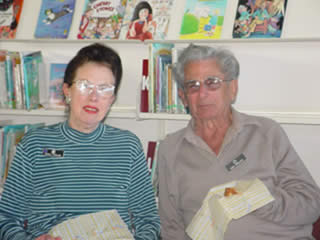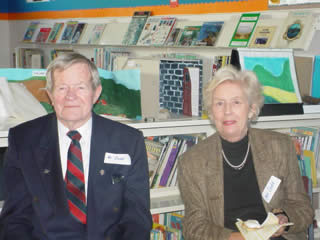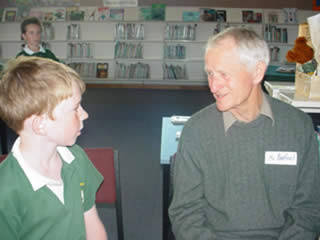 |
 |
|
||
Churchill Park School
History of Churchill Park, Glendowie, and St Heliers
Our project
Here are some of the discoveries we made about our area.
TAHUNA TOREA
I didn't really know much about Tahuna Torea Nature Reserve, and I didn't really think about it. After my study, I found out a lot more knowledge and I'm glad. Ronald Lockley was a stranger to me. Now I know that he created the reserve.
Tahuna Torea means 'the gathering place of the oystercatcher'. Tahuna Torea lies at the east end of West Tamaki Road, in Glendowie. From my interview with Mr Christopher Barfoot, I learned that Tahuna Torea's first plans were a dump site. But with help from the neighbours (including Mr Barfoot), Ronald Lockley changed it into a reserve. They made paths, planted trees and built the duck pond. Sooner or later, there was a beautiful nature reserve. My family would definitely not want to live there if there was a dump instead of a reserve. Many local families and schools now use this beautiful natural environment and bird sanctuary for walks and studies.
By Ximena
ST HELIERS BAY
St Helier was born in Tongues in Belgium. He moved to Jersey in the British Isles. He was martyred by sea rovers and pirates. A special saint's day was named after him. In about 1880, several land owners bought properties and formed a land investment company, taking shares in the stock exchange. This company was called St Heliers Land Co. Churchill Park was further to the east and over the hill from Karaka Bay.
From the early days of the 1920s, families have come to St Heliers for picnics, festivals and a day out at the beach. Because there were no roads in the early days, the families travelled on a ferry, and there was a landing pier for the boats to off-load the people. The original Māori name for St Heliers was Whangi-nui, meaning 'large bay'.
It was at Karaka Bay, very close to St Heliers Bay, that the Treaty of Waitangi was signed by representatives of Queen Victoria and the chiefs of Tamaki. It came to be called St Heliers in 1883, because Major Walmsey, a stud manager at Glen Orchid Farm, saw in it a likeness to St Heliers, the chief town of Jersey in the British Isles.
CHURCHILL PARK PRIMARY SCHOOL
The site for the school, which is 8 acres in size, was taken by proclamation by the Department of Education from Churchill Park in 1962. Work began on the site in 1962, and the first classrooms were completed in November 1963. It was opened in February 1964, with a roll of 120 students. At that time there were 4 classrooms and the offices. Mr Rob Muldoon opened the school officially on 28th November 1964. Mr Muldoon mentioned that the school would benefit greatly from the wonderful park it was on and the many houses that had growing families living in the area. Mrs Brightman came to our afternoon tea, and she was a former Deputy Principal in the 1970s. She told us many funny stories, including the flooded and floating parts of the playground, because the drainage failed and the whole area needed to be drained and sealed again.
Our beautiful school still sits alongside the open fields of Churchill Park. Churchill Park was named after Sir Winston Churchill, the great Prime Minister of England in World War II. We often look over the fence at the grazing cows and waving pine trees. The Auckland City Council take care of maintaining this natural reserve, that is available for everyone to take walks and jog in the park!
EARLY RESIDENTS SHARE THEIR STORIES WITH RESEARCH GROUP STUDENTS
On June 2nd we invited 20 senior citizens to share afternoon tea and tell their stories to us. We had afternoon tea and found out lots of information from all the people.


We learned that going to town was an all-day trip in the 1940s. The people walked to the bus stop and then got dropped in St Heliers to take a ferry to Auckland. Then as the shops were started, a van and shopkeeper would come around to the settlers and sell cloth for clothing, and the grocer would take orders and deliver the food. Many of our visitors went to St Heliers School in the 1920s and on to 1950, and they would walk up to 5 miles in bare feet in the winter to get to school. Back in the 1920s some students came to school on horseback.

More of our findings are included here, through our articles. We learned a lot of interesting history about our area.
GLENDOWIE AREA
One of the old families of this area was the Taylor Family. The Taylors suggested the name "Glendowie", which came from two words: 'Glen' from the Scottish word for a narrow valley, and 'dowie' which is from "Bardowie" the name of the Perthshire estate of close relatives of the Taylor family. The Taylors farmed in the area in the early days. Richard Taylor was a trustee of the Highways Board in 1870 and assisted in the formation of "Massey Road", that today we know as Maskell Road.
George Riddell in 1912 purchased 582 acres of local land and from the original Glendowie estate, and the construction of Riddell Road began. Many of our school families live on this road (that also runs alongside Churchill Park at one point). Soon the land was subdivided in parcels of land for small farmlets.
The Glendowie Golf Club purchased 134 acres from Mr Riddell and officially opened in 1925. As mentioned, when World War II came and many men went off to war, the Golf Club disbanded, although the original clubhouse still remains. The Auckland City Council has made Churchill Park a natural preserved land and park site now, and so we can enjoy it!
We, the research group, enjoy our closeness to the ocean and also now see how fortunate we are to have the beauty of the park just over the fence. AND we are only 20 minutes car-ride to downtown Auckland!
Next > Research Process
Last update: Thursday, July 31, 2003 at 5:14:07 PM. Churchill Park School.